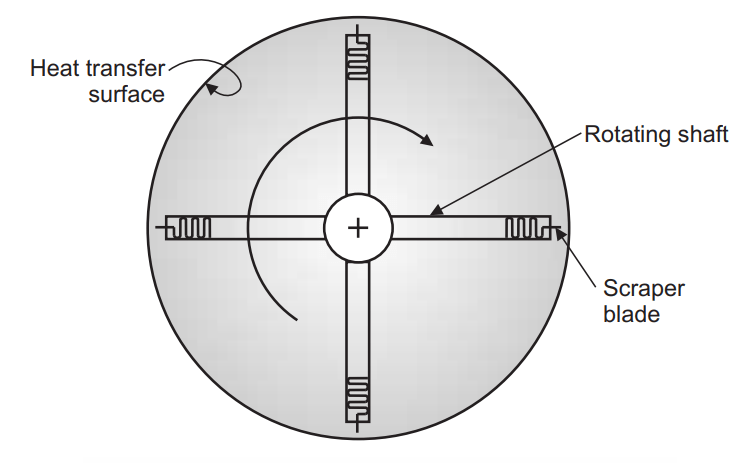Scraped Surface Exchangers: In some of the heat interchangers the drag forces due to the flow of viscous liquid, a quite thick viscous sub-layer or due to turbulent conditions in the core, liquid exhibits no pressure loss with excessive pumping costs. This problem is solved by physically removing the layers of fluid at the heat transfer surfaces and mixing them with the bulk fluid in the heat exchanger. In this way, if the fluid is being heated, heat is conveyed directly from the wall to the bulk liquid. The technique is particularly attractive for heat-sensitive liquids used in pharmaceutical products because it has a low interface temperature between the liquid and heat transfer surface for a given overall temperature driving force.
These types of exchangers have a rotating element with spring-loaded scraper blades, (Figure given below), to scrape the inner heating surface to effectively remove liquid from it. The blades move against the heat transfer surface under the influence of the rotational forces. Simultaneously, as liquid layers are removed any fouling substance deposited on the surface is also removed. This ensures no contamination of the processed liquid with no change in product qualities. The number of scraper blades may vary but as the number of blades is increased the capital cost rises. A large number of blades are not necessary, since the time interval between successive scrapes is relatively short. The choice of the number of blades is an empirically based compromise between capital cost, acceptable speed of rotation, and liquid viscosity. Rotating parts in these exchangers makes the maintenance costlier.

Some exchangers have blades that do not actually touch the surface over which they pass but move in close proximity to it. Such designs may be termed as “wiped surface” heat exchangers and may be preferred, where the wear of components cannot be tolerated from a viewpoint of mechanical or contamination effects. Scraped surface heat exchangers can either run full of liquid or the liquid may enter the exchanger as a peripheral stream. The design of this heat exchanger is complex and is made usually based on empirically determined parameters derived from experience. Scraped surface heat exchangers are, in general, used only for special applications.